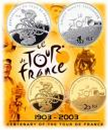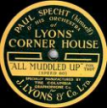Sometimes it seems that our industry is behaving like Chicken Little – rushing around thinking that the sky has fallen on all of our heads. Steve and I think that there is a real value to looking backwards in order to think and create forwards.
We talked about our Brief History of “advertising”Creativity at the IPA 44 Club on Monday night.

100 years ago two French newspapers were locked in a ferocious head to head circulation battle – L’Auto and Le Velo. The guys at L’Auto came up with an ingenious idea to help promote their brand. What if, they said, we created a sporting event that L’Auto owned? Cycling has always been a hugely popular sport in France and at the turn of the century it was a national obsession. And so the Tour De France was born. On the 19th January, L’Auto announced: “the greatest cycling trial in the entire world. A race more than a month long: Paris to Lyon to Marseille to Toulouse to Bordeaux to Nantes to Paris.”
L’Auto went from selling 54k copies a day to at its height in 1933 selling 854k copies a day
Oh and by the way its competitor had gone backrupt years earlier.



Staying in France, around the same time Andre Michelin the CEO of the Michelin tyre company looked at the changing habits of the French. They were starting to drive at the weekends around France on little mini-breaks. Thinking about how the Michelin type brand could actually be useful to its customers and potential customers Andre Michelin created the first Michelin Guide in 1900.
Branded Utility, anyone?
In 1920 Andre decided that if people got content for free then they did not value it as much as if they paid for it. So decided to charge for it. As motoring spread, so did the guide. It is now the most powerful restaurant guide in the world, a guide that results in suicides if a Michelin star is lost.


Moving to the UK, Lyons Tea and Coffee Company saw a major demographic shift after the war – the birth of the teenager and young urban office workers. These people wanted a place to meet, eat, drink, flirt, chat and also listen to music. The Lyons Corner Houses were the Starbucks of their generation. In fact they were so taste-making that they even had a record company so that if you liked the Big Band music that was being performed in store you could walk down to His Masters Voice and buy the record.
Sound anything like the Starbucks and iPhone Touch deal that just got announced?
And finally, thinking about something a little less sexy, soap powder.
P&G needed to advertise their soap powder, but what they soon realised in the 1930s that although people were listening to the wireless, there were no shows that generated a large audience. So they created the world’s first soap opera Ma Perkins in 1993. By the 1950s it was obvious that the new channel of choice was television, so partnering up with CBS the US television network P&G developed the first TV soap opera As The World Turns (still the world’s most succesful soap) They were platforms that P&G could build on to communicate their branded messages.
Similar to the work that Imagination and Ford are doing online at the moment with Where Are The Jonses?
We find it interesting to think about how ahead of their times and just how creative this thinking was.
And some of it happened over 100 years ago.
Are there any other examples from the past that have inspired you to think differently?





